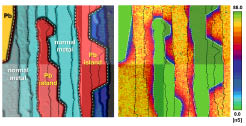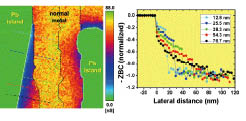Visualization of "Reflectionless Tunneling" in the Superconducting Proximity Effect
Hasegawa and Kato Groups
When a superconducting material is brought into contact with a normal metal, superconducting properties penetrate into the metal. The phenomenon called proximity effect has been utilized to induce the pair correlation into various materials, including topological insulators to realize elucidating Majorana fermions.

Fig. 1. (left) STM image of Pb islands on a Pb-induced two-dimensional normal metal formed on a Si substrate (1.0 μm square). The edges of the Pb islands and the steps of the normal metal layer are highlighted with white and black dotted lines, respectively. (right) The zero-bias conductance (ZBC) color map of the same area as in the topographic image.

Fig. 2. (left) 400 nm × 400 nm ZBC color map taken on a confined area surrounded by the Pb island and a step edge of the normal metal layer. (right) Normalized negative ZBC profiles across the super/normal interface and the step edges measured along the colored lines drawn in the topographic image. The length written for each plot is the terrace width measured along the corresponding line.
The propagation of the proximity effect depends on the distribution of scattering centers in the normal metal, as you may expext. But curiously, it is enhanced by the presence of elastic scatters. The proximity effect is caused by the Andreev reflection at the super/normal interface, where injected electrons from the normal metal is retro-reflected as a hole whose phase is conjugated with that of the electron. Elastic scatters redirect reflected electrons/holes toward the interface, making a loop in their trajectories with the interface. Because of constructive quantum interference due to the phase conjugation, the looped trajectories enhance the probability of the Andreev reflection and consequently proximity effect. As the Andreev-reflected quasiparticles can tunnel though the interface without reflection, the enhancement is called reflectionless tunneling.
Using scanning tunneling microscopy (STM), we studied the proximity effect and the roles of the atomic-scale defects in real-space with nano-meter scale spatial resolution. The measurement was performed at 2.15 K in ultrahigh vacuum. The proximity effect was characterized via tunneling spectroscopy of a gap formed by the pair correlation at the Fermi energy. The investigated super/normal interface was formed in situ by creating superconducting Pb islands on a Pb-induced two-dimensional (2D) normal metal formed on a Si substrate. In Fig. 1, a topographic STM image (left) and a mapping of the corresponding conductance at the bottom of the gap, that is, zero bias conductance (ZBC) mapping (right), are shown.
In the ZBC mapping, all Pb islands are colored green, which indicates zero ZBC and good superconductivity there, and the normal metal far from the Pb islands is colored yellow, indicating no gap there. The area surrounding the Pb islands has the color of blue to red, implying a gap formation by the proximity effect. The gap propagates from the superconducting Pb islands and decays into the normal metal with the coherence length ξ of 40 nm. It is found from the mapping that the proximity effect strongly depends on the atomic structure of the interface; it is strong at the place where a Pd island is directly sitting on the 2D layer, and basically no gap formation is observed at the edge of the island that coincides with the downward step of the 2D layer. The observed structural dependence can be explained by the variation of the conductivity at the super/normal interface.
We also found that the surface steps severely block the propagation, which indicate they behave as a strong potential barrier or an elastic scatter for the two-dimensional electrons. In order to find the role of the steps on the proximity effect, we investigated an area where the step is very close to the super/normal interface shown in Fig. 2 (the upper left of Fig. 1). In the wedged area whose terrace width ranges from almost 0 to 2ξ we observed the enhancement of the gap and found that deeper gap is formed on narrower terrace, as demonstrated in the right panel of Fig. 2, which shows ZBC profiles for various width terraces. Because of the real-space and cross-sectional observation, we can probe ZBC throughout the system while eliminating unwanted effects of structural defects at the super/normal interface and in the normal metal. The observed enhancement is overall consistent with the reflectionless tunneling. The dependence of the enhancement on the terrace width is, however, not explained quantitatively with the calculation based on the Usadel equation, a quasi-classical Green's function formalization. Some phenomena that are not considered in the calculation are probably involved in the enhancement of the proximity effect.
References
- [1] H. Kim, S.-Z. Lin, M. J. Graf, T. Kato, and Y. Hasegawa, arXiv:1401.2602
